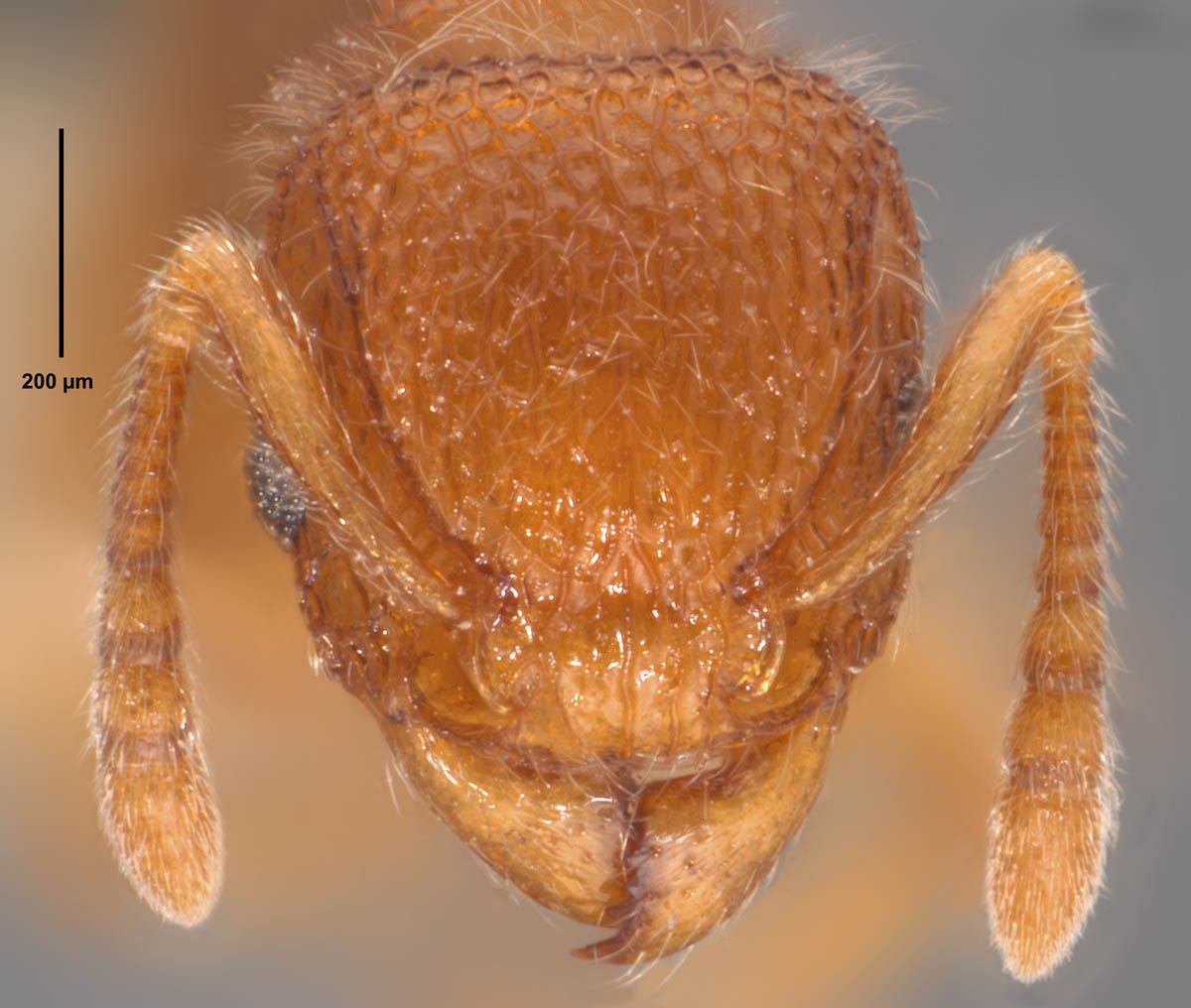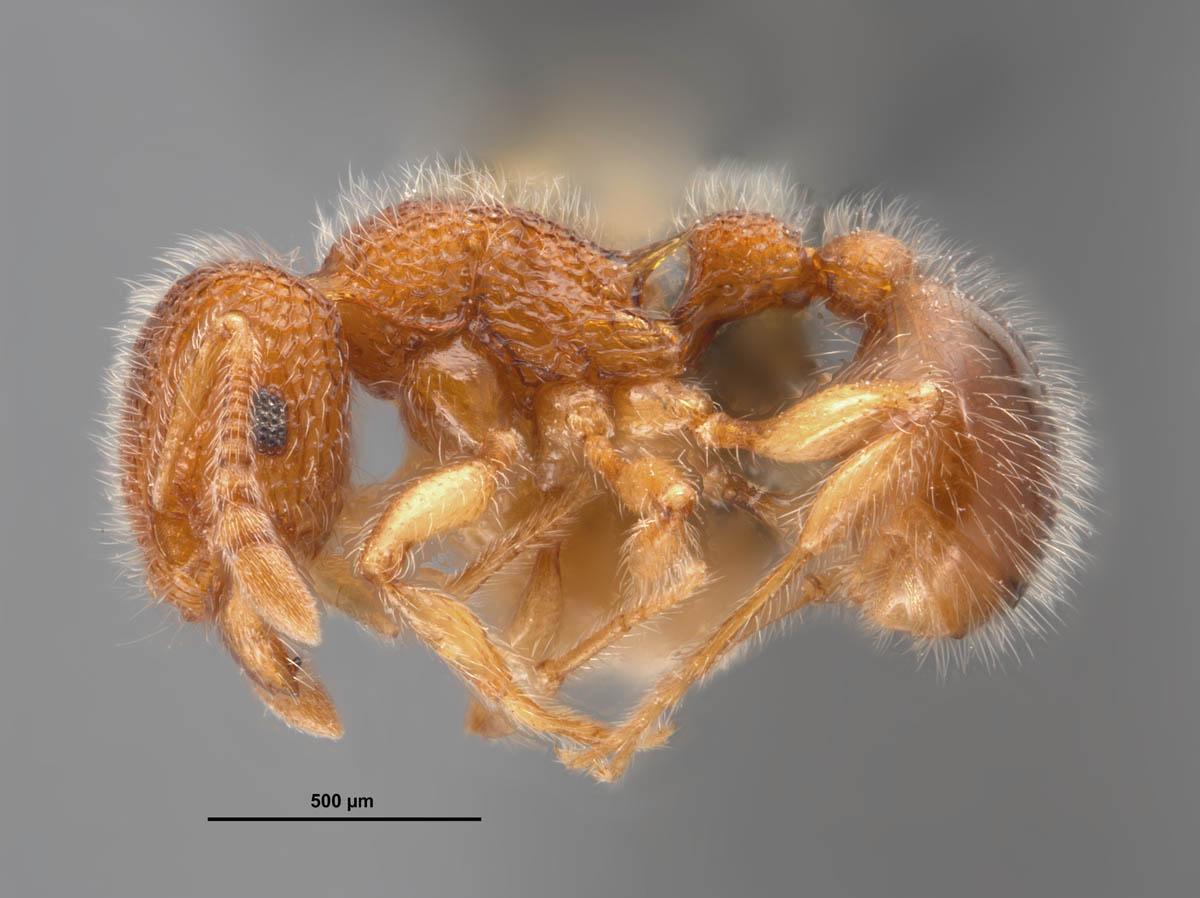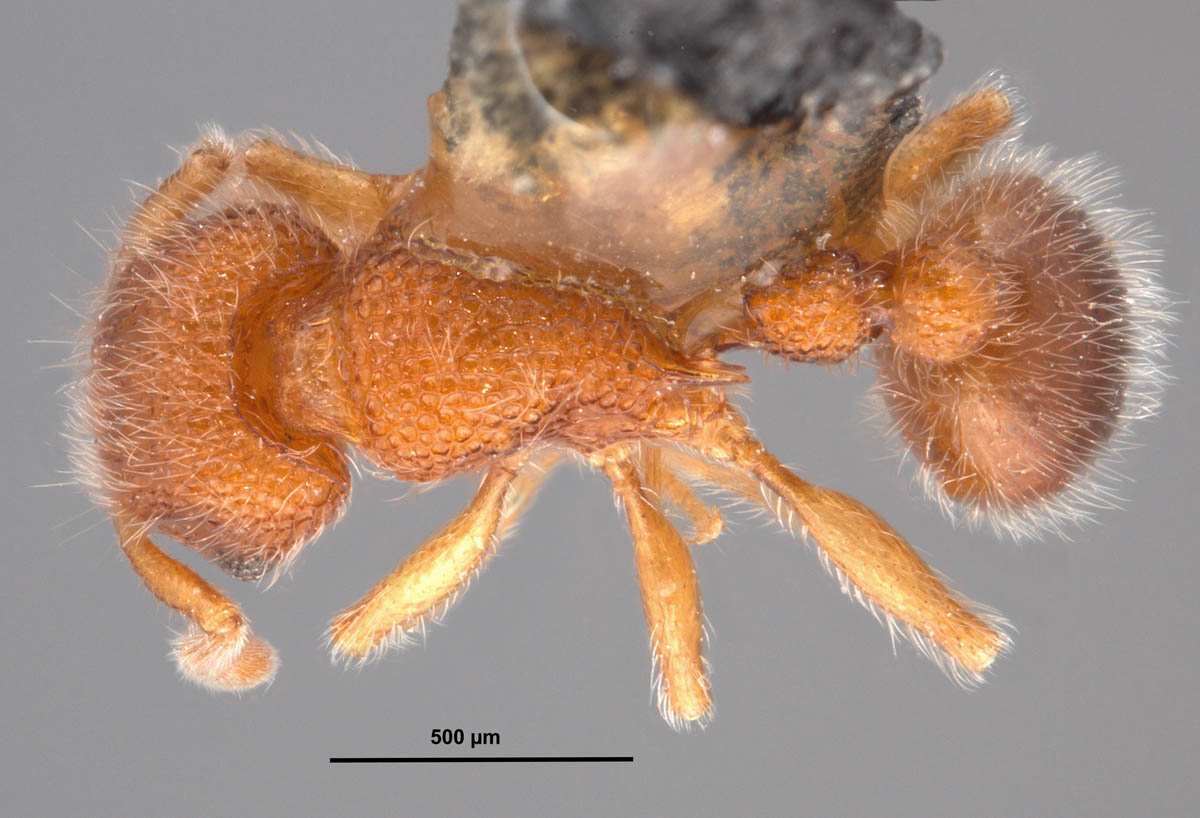Introduction
Tetramorium species are distributed worldwide with the largest diversity in being in Africa. Several species have been spread across the globe by human commerce. Non native species are generally found in urban environments and often in large numbers.
Tetramorium species can be identified separated from other myrmicine spines but the combination of the following characteristics: lateral part of the clypeus forming a sharp wall anterior to the antennal insertion; frons; 11 or 12-segmented antennae with three-segmented antennal club; antennal scrobe present from antennal insertion point to the posterior corner of head; two segmented waist; sting with a lamellate appendage found apicodorsally that projects at an angle to the long axis of the sting shaft.
Tetramorium lanuginosum Mayr (Myrmicinae), the wooly pavement ant, is a small, reddish brown wooly ant native to tropical and subtropical Asia. This species has only been rarely collected in the continental US, and many of the records of it are historic.
Taxonomic History (Bolton 2016)
Tetramorium lanuginosum Mayr, 1870: 976 (w.) INDONESIA (Java). Indomalaya. "Indonesia, Java, Batavia." Naturhistorisches Museum, Wien, Austria (NHMW). CASENT0235202. Viehmeyer, 1916: 140 (q.); Imai, Baroni Urbani, et al. 1984: 8 (k.). Combination in Triglyphothrix: Emery, 1891: 4 (footnote); in Tetramorium: Bolton, 1985: 247. Senior synonym of Tetramorium australis, Tetramorium ceramensis, Tetramorium felix, Tetramorium flavescens, Tetramorium laevidens, Tetramorium mauricei, Tetramorium orissana, Tetramorium striatidens, Tetramorium tricolor:Bolton, 1976: 350. See also: Hita Garcia & Fisher, 2011: 27.
Diagnosis
Tetramorium lanuginosum can be separated from other similar species in in the southeastern US by the dense covering of plumose setae present on the entire body; dense, rugoreticulation on the head, mesosoma, and waist; and the elongate, straight propodeal spines.
Identification
Worker: Small (HL 0.66-0.69mm, HW 0.59-0.63mm, SL 0.42-0.46mm, EL 0.14-0.15mm, MeSL 0.68-0.70) (n=5) (MEM specimens). Overall light reddish brown to dark brown, gaster slightly darker, and legs yellowish brown. Head squarish, slightly longer than wide; with tightly woven, deep rugoreticulation; entire head with dense short, erect, whitish plumose-like setae (setae with 2–3 branches); eyes small, located laterally near the midline of the head; frontal process widened over the antennal insertion; antennal scrobes present, curving from antennal bases to posterior corners of the head,; antennae 12-segmented with a three-segmented club; apical segment of antennal club over half the length of club; posterior edge of clypeus forming an abrupt wall anterior to the antennal insertion point; mandibles triangular. Mesosoma smoothly arced in profile view; entire mesosoma with densely woven rugoreticulation; dense short, erect, whitish plumose-like setae abundant; propodeal spines straight, elongate; propodeal lobes small, triangular, acute; legs lacking sculpture, with numerous bifid setae. Waist two-segmented; with strong reticulate sculpture; with dense short, erect, whitish plumose-like setae especially dorsally; both petiolar node and postpetiolar node sub-circular when viewed dorsally; petiole squarish in profile. Gaster, lacking sculpture, shiny; with numerous, simple and bifid setae; first tergite enlarged, more than half then length of gaster; sting with a lamellate appendage found apicodorsally that projects at an angle to the long axis of the sting shaft.
Queen: Slightly larger than workers (No MEM specimens, based on antwiki.org pictures) Color ranges from orangish brown to brown with a slightly darker colored gaster. Head slightly longer than wide; with deep, tightly woven rugoreticulation; dense short, erect, whitish plumose-like setae present; eyes located laterally near midline of the head; three ocelli present; antennae 12-segmented with a three-segmented club; posterior edge of clypeus forming an abrupt wall anterior to the antennal insertion point; mandibles triangular. Mesosoma enlarged, subquadrate, mesoscutum and mesoscutellum contiguous, flattened; dense rugoreticulation present on entire mesosoma except katepisternum, which is smooth, shining; dense short, erect, whitish plumose-like setae present, especially dorsally; propodeal spines elongate. Waist two-segmented; with dense reticulation; dense short, erect, whitish plumose-like setae present; both nodes sub-circular. Gaster, lacking sculpture, shiny; with numerous, simple and bifid setae; first tergite enlarged, more than half then length of gaster; sting with a lamellate appendage found apicodorsally that projects at an angle to the long axis of the sting shaft.
Male: Unknown.
Biology and Economic Importance
Tetramorium lanuginosum can be found in tropical and subtropical regions worldwide. It has an almost continuous range going from India all the way to northern Australia where it can be found in rural and urban environments, which indicates that this could be its native range (Wetterer, 2010). Outside of Southeast Asia, T. lanuginosum is commonly found in the South Pacific Islands and around Madagascar. Tetramorium lanuginosum has been introduced to the Southeastern Gulf States, though it has not been reported to be extremely prevalent. This suggests that the endemic ant species on the area and other nonnative ants could be outcompeting it.
Tetramorium lanuginosum currently does not pose a large economical threat in the southeastern United States or a lot of the mainland areas where it can be found. It could potentially become a significant pest on islands where there is less competition with other ants though (Wetterer, 2010).
Pest Status
Distribution
Native Range: Tropical to subtropical Southeast Asia (Wetterer, 2010)
Australian: American Samoa, Australia, Federated States of Micronesia, Fiji, French Polynesia, Guam, Hawaii, Indonesia, Kiribati, Marshall Islands, New Guinea, Samoa, Solomon Islands, Tokelau, Tonga, Wallis and Futuna Islands (AntWeb.org and AntWiki.org).
Ethiopian: Comoros, Madagascar, Mauritius, Mayotte, Réunion, Seychelles, United Arab Emirates, Yemen (AntWeb.org and AntWiki.org).
Nearctic: United States (AntWiki.org and MEM).
Neotropical: Aruba, Barbados, Costa Rica, Dominican Republic, Ecuador, Galapagos Islands, Greater Antilles, Mexico, Netherlands Antilles, Nicaragua, Puerto Rico (AntWeb.org and AntWiki.org).
Oriental: Bangladesh, Bhutan, Borneo, India, Krakatau Islands, Malaysia, Myanmar, Nicobar Island, Philippines, Singapore, Sri Lanka, Thailand, Vietnam (AntWeb.org and AntWiki.org).
Palearctic: China, Iberian Peninsula, Iraq, Israel, Japan, Malta, Saudi Arabia, Spain (AntWeb.org and AntWiki.org).
U.S. Distribution: AL, FL, GA, HI, LA, MS, SC (AntWeb.org and MEM).
Southeastern U.S. Distribution: AL, FL, GA, LA, MS, SC (AntWeb.org and MEM).
Acknowledgments
Funding for the ant work being done by the MEM in Alabama and Mississippi is from several sources including the National Institute of Food and Agriculture, United States Department of Agriculture, under Project No. MIS-012040, the Mississippi Agricultural and Forestry Experiment Station at Mississippi State University, with support from State Project MIS-311080, NSF Grants BSR-9024810 and DFB-9200856, the Tombigbee National Forest (U.S. Forest Service), the Noxubee Wildlife Refuge, Mississippi Natural Heritage Program Research Grant, USDA Forest Service Agreement No. 08-99-07-CCS-010, the William H. Cross Expedition Fund, and primarily by the USDA-ARS Areawide Management of Imported Fire Ant Project (2001-2014) and USDA-ARS Areawide Management Invasive Ants Project. Additionally, special cooperation has been provided by State Parks, National Forests, National Wildlife Refuges, the Natchez Trace Parkway, and from various private landowners in both Alabama and Mississippi.
Literature Cited
Bolton, B. 1976. The ant tribe Tetramoriini (Hymenoptera: Formicidae). Constituent genera, review of smaller genera and revision of Triglyphothrix Forel. Bulletin of the British Museum (Natural History). Entomology 34:281-379.
Bolton, B. 1985. The ant genus Triglyphothrix Forel a synonym of Tetramorium Mayr. (Hymenoptera: Formicidae). Journal of Natural History 19:243-248.
Bolton, B. 2016. Bolton World Catalog Ants. Available online: http://www.antweb.org/world.jsp. Accessed 16 May 2016.
Emery, C. 1891. Exploration scientifique de la Tunisie. Zoologie. - Hyménoptères. Révision critique des fourmis de la Tunisie. Paris: Imprimerie Nationale, iii + 21 pp.
Hita Garcia, F.; Fisher, B. L. 2011. The ant genus Tetramorium Mayr (Hymenoptera: Formicidae) in the Malagasy region—introduction, definition of species groups, and revision of the T. bicarinatum, T. obesum, T. sericeiventre and T. tosii species groups. Zootaxa 3039:1-72.
Imai H. T., Baroni Urbani C., Kubota M., Sharma G. P., Narasimhanna M. N., Das B. C., Sharma A. K., Sharma A., Deodikar G. B., Vaidya V. G. & Rajasekarasetty M. R. 1984. Karyiological survey of Indian ants. Jpn. J. Genet. 59: 1-32.
Mayr, G. 1870. Neue Formiciden. Verhandlungen der Kaiserlich-Königlichen Zoologisch-Botanischen Gesellschaft in Wien 20:939-996.
Viehmeyer, H. 1916 ("1915"). Ameisen von Singapore. Beobachtet und gesammelt von H. Overbeck. Archiv für Naturgeschichte (A)81(8):108-168.
Wetterer, J.K. 2010. Worldwide spread of the wooly ant, Tetramorium lanuginosum (Hymenoptera: Formicidae). Myrmecological News 13: 81-88.
Links
AntWeb
AntCat
AntWiki





